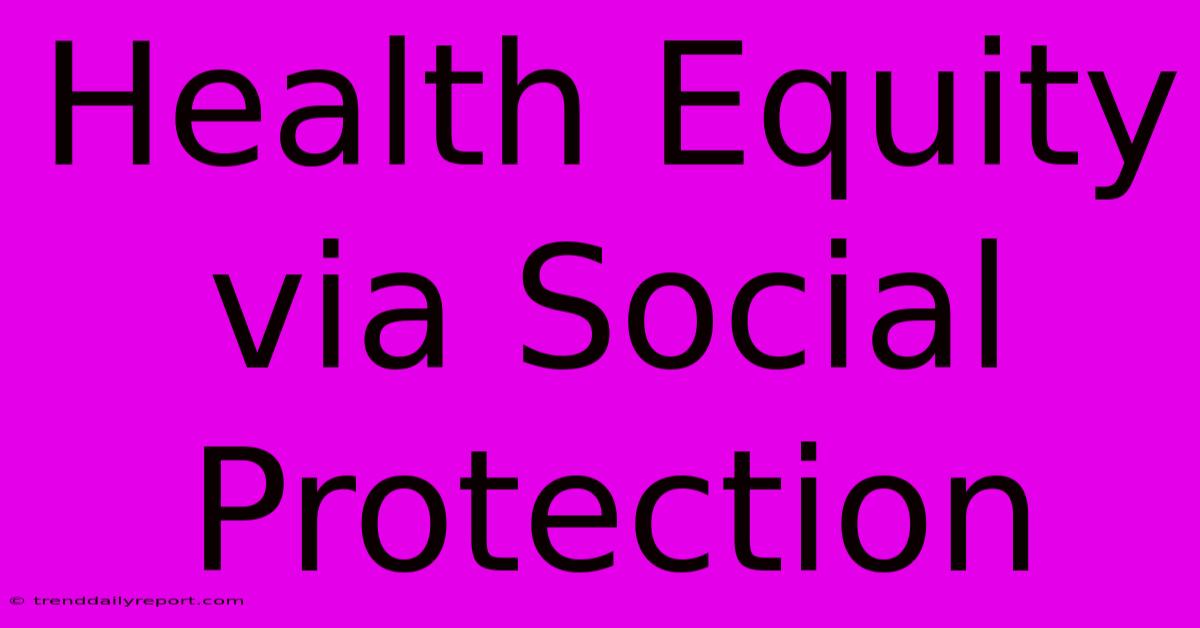Health Equity Via Social Protection

Discover more detailed and exciting information on our website. Click the link below to start your adventure: Visit Best Website Health Equity Via Social Protection. Don't miss out!
Table of Contents
Health Equity via Social Protection: My Journey to Understanding a Complex Issue
Hey everyone, so I wanted to talk about something that's been on my mind a lot lately: health equity, and how social protection plays a HUGE role. It's a complex topic, trust me, I've spent way too much time wrestling with it! But I've learned a few things along the way that I think are worth sharing. It's not like I'm some kind of expert, more like I’ve been on a personal quest, stumbling and learning.
What Even Is Health Equity?
Okay, let's start with the basics. Health equity isn't just about making sure everyone has access to healthcare; it's about making sure everyone has a fair and just opportunity to be healthy. This means tackling those pesky social determinants of health – things like poverty, lack of education, discrimination, and unsafe living conditions. These things, they're major roadblocks, you know?
I remember this one time, I was working on a project analyzing health data in a rural community. I was so focused on the numbers – the rates of diabetes, heart disease, etc. – that I almost missed the bigger picture. The why behind those numbers. Turns out, lack of access to healthy food and reliable transportation were huge factors. It was a total "duh" moment, but a crucial one.
The Role of Social Protection
This brings me to social protection. Think of it as a safety net – programs and policies designed to reduce poverty and vulnerability. Examples include things like unemployment benefits, cash transfers, and food assistance programs. These programs aren't just about handing out money; they're about empowering people to improve their health and well-being.
Social protection programs can directly address those social determinants of health I mentioned earlier. For example, a cash transfer program can help families afford nutritious food and healthcare, while unemployment benefits can provide financial stability during tough times.
This isn't some pie-in-the-sky idea, either. There's tons of research showing the positive impact of social protection on health outcomes. A study from [insert credible source here - e.g., World Bank] showed a significant reduction in child mortality rates in countries with strong social protection programs. Pretty amazing stuff, right?
My Biggest Mistake (and What I Learned)
One of my biggest mistakes early on was thinking of social protection as a separate issue from health equity. I'd approach things in silos – working on a health campaign here, a poverty reduction initiative there – without seeing the connections.
That was a huge oversight! It’s like trying to fix a leaky faucet by only patching the holes, instead of looking for the main problem with the pipes. You gotta see the whole picture!
Now, I try to integrate social protection into all aspects of my work on health equity. It's about collaborating with different sectors – healthcare providers, social workers, government agencies – to create comprehensive and sustainable solutions.
Practical Tips for Integrating Social Protection into Your Work
So, what can you do? Even if you're not a policymaker, you can make a difference.
-
Advocate: Support policies and programs that strengthen social safety nets. Talk to your elected officials. Let them know this stuff matters!
-
Collaborate: Partner with organizations working on both health and social protection. Together we can achieve more.
-
Educate: Spread the word about the importance of health equity and social protection. Talk to your friends, family, and colleagues – you never know who you might influence.
-
Research: Stay informed about the latest evidence and best practices. Knowledge is power, my friend!
In short: Health equity and social protection are intrinsically linked. By addressing the social determinants of health, we can create a healthier and more equitable world for everyone. It's a long journey, but with collaboration and effective strategies, we can make real progress! Let’s work together to make healthcare more accessible and equitable for everyone. We can do it!

Thank you for visiting our website wich cover about Health Equity Via Social Protection. We hope the information provided has been useful to you. Feel free to contact us if you have any questions or need further assistance. See you next time and dont miss to bookmark.
Featured Posts
-
City Feyenoord Champions League Live
Nov 27, 2024
-
Champions League J5 Team Lineup Predictions
Nov 27, 2024
-
Ucl Clash Grealish Ake Nunes Play
Nov 27, 2024
-
Mc Gregor Brand Whiskey Source Update
Nov 27, 2024
-
Ucl Man City Vs Feyenoord Live
Nov 27, 2024
